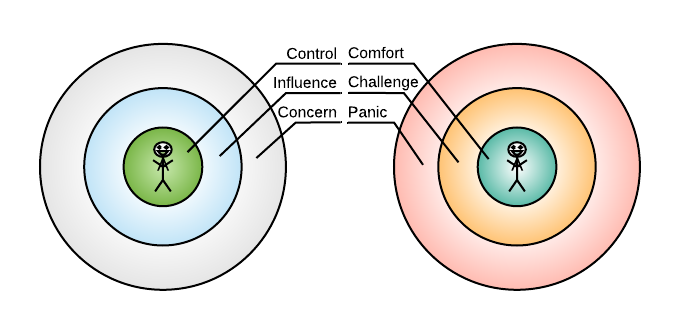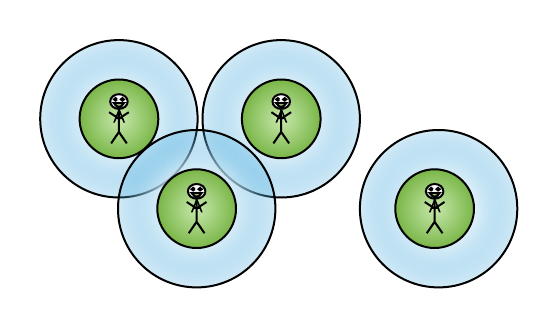Leadership Model: Be the Center of the Universe
Posted by Dennis Mnuskin in mental model 5 years, 5 months ago

Recently, I’ve taken some time to create an actual homepage for my website, and while doing so I’ve written a few paragraphs about leadership. I touched a bit on a mental model that I use quite frequently both for my own personal journey as well as in growth/career conversations with others in professional settings.
In this post, I’d like to expand on that and share with the reader how this model of you at the center of the universe has been helping me think about and have conversations with others about growth and leadership.
Potential Elephant
Before we dive in, let’s address a potential elephant here. There might be a thought floating around, isn’t this a bit too self-centered? How am I at the center of the universe? Are we going back to the days before Copernicus?
For starters, I don’t know where the edges of the universe are. Without clear boundaries (as far as I know), who is to say that you are not at that center? Then again, the focus here is not so much about navigation through space as through life. And from the perspective of how we experience our lives, all we have is…
- Five senses which allow us to experience everything and everyone else around us
- Preexisting mental constructs which help us interpret information we receive through the other senses. In some Eastern philosophies, these are referred to as the sixth sense but even these enter our minds through prior events experienced by one or more of the first five.
Each of us is constantly bombarded by the incoming information from every direction and based on that, we build our own interpretation of the world around us. Sometimes we get a bit ahead of ourselves and believe that what we perceive must be universally true. Sometimes that is indeed the case. However, what we do not always remember is that if every single person is at the center of their universe and uses their senses the same way we do, their world may not always be completely identical to our world.
For the scope of the rest of this post, the key is to recognize that every person is at the center of the universe as they see, experience and engage with it.
The Model
What’s presented here started off as two different models that I came across a few years apart from each other during my own journey. However, these two models have very similar shapes and I found that they work so well in tandem that they might as well be treated as two dimensions of the same model. And here they are:

The first one was introduced to me by Stephen Covey in his book 7 Habits of Highly Effective People. It demonstrates three concentric circles each identifying a boundary of...
- Control - the aspects of our lives over which we are able to exert full control (e.g. pencil on my desk in front of me)
- Influence - the aspects of our lives over which we are able to exert at least some influence but not full control (e.g. my spouse or the child)
- Concern - the aspects of our lives over which we neither have any control or influence yet we still think about (e.g. the weather)
The second one came to me a bit more gradually as I first heard about it while listening to Pema Chödrön’s talk, but then it was reinforced by literature on personal growth and business leadership and then in a HR-facilitated team building workshop at my workplace. From its perspective, the second one demonstrates that around us are the zones of...
- Comfort - combined set of skills/activities that are easy for us. We may consider ourselves experts at these.
- Challenge - combined set of skills/activities which are not easy. When performed, these push us to acquire new expertise we might not have today.
- Panic - combined set of skills/activities that overwhelm us to a point where we feel that we are no longer even able to hold our head above water.
Interpretation
Everyday when we show up in our personal and professional lives, we get to decide which circle/zone we are going to operate in today. Sometimes it is not a conscious decision, but just about always, the choice is there.
Dimension of Control-Influence-Concern
- Circles of control and influence are the only two circles where we have agency, where we can exert our energy to make a difference.
- Circle of concern may have important causes and is fun to visit from time to time, possibly even useful, but it is important to recognize that time and brain cells devoted to this circle will, by definition, not produce any meaningful impact in your life.
- As Covey points out, when not paying careful attention, many of us tend to overestimate our own ability and spend a disproportionately large amount of time hanging out in the circle of concern. It becomes very important for us to learn to recognize the boundary between influence and concern. If you feel stuck and unable to make a difference, it might be important to pause, take a step back and ask which of the circles you are operating in?
- The flip side of the previous point, we often do not pause long enough to consider all options that are available to us within our circle of influence. Are there avenues we haven’t explored? Are there people we have not reached out to yet? Have we asked those people the right questions?
- As we grow personally and/or professionally, the areas of control and influence will naturally expand. So that one day, what was once a distant concern could become something you will be able to make an impact.
- It is very difficult to continue to operate in the circle of influence without establishing a solid foundation of control
Dimension of Comfort-Challenge-Panic
- No one grows by being comfortable. Learning happens in the challenge zone. It is the place that continuously tests the limits of what we are capable of today.
- Oftentimes the challenge zone is not comfortable and sometimes it is downright miserable or scary.
- Panic zone is important to consider so that we build awareness of where it begins and what it feels like. Life is full of ups, downs and unexpected surprises. What is a challenge one day, could easily overwhelm us the next.
- Panic zone is where the defense mechanisms kick in and we shift from openness and growth to huddling up and surviving. All learning stops. If you find yourself here, it’s time for a reset.
- Comfort zone is incredibly important as it continuously serves as your base of operation. It is your safety and your foundation. It is the place you return to when you need to reset or recharge (see previous point).
- It is difficult to remain in the challenge zone without an established solid foundation of the comfort zone. On the other hand, as Thomas Fuller once said, “All things are difficult before they are easy.” Challenge zone also has the important role of building and reinforcing that very same foundation.
Interrelationship Between These Dimensions
- Things which are easy are often those over which we also have full control.
- Things that prove challenging are generally those over which we have no direct control, but only influence.
- What triggers the transition into the panic zone might simply be too much going on, but it can also happen when we lose sight and end up exerting energy on things that we neither control nor influence, which unfortunately happens all too often.
- In terms of both dimensions, it is important to establish and maintain a solid foundation as a base from which to operate.
- Use that solid base to venture out and continuously test your boundaries of what’s challenging and what can be influenced. Doing so regularly will reinforce and expand your foundation while expanding your reach
- Corollary of previous point, not venturing out to test your boundaries will most likely result in your foundation shrinking over time as skills/techniques you’ve acquired will become less and less relevant.
Takeaways
The information in this section may not apply universally across all people and all professional settings as I am offering the observations based in large part on my own direct experience working in software development as well as a more recent transitioning into a management role within the same industry.
Career Growth Path
When considering growth from the perspective of the model presented here, we can generalize by simply saying that you will move up on the career ladder every single time you are able to expand your circles. So a question, “what’s next for me?” which I hear quite frequently, could be reframed as a set of...
- What is at the boundaries of my circle of influence? Where should I expand my reach?
- Where does my foundation (i.e. inner circles) may need to be reinforced so that I have more time/energy available to periphery?
- What skills/activities present a challenge for me? Which of these would be helpful at my edges of influence? Which of these would be helpful to reinforce/expand my foundation?
- What skills/activities cause me to go into a panic mode? What can I work on to reinforce some related skills in that area?
If we consider a typical software engineer career path, everyone enters the workforce with very little control over anything and just about every single task feels like a challenge. As the person progresses, what was hard becomes easy and they start taking on more difficult tasks as their area of responsibility (and comfort) grows. This model remains consistent all the way up to an enterprise architect whose role would be to guide and influence (not so much as control) the technical product direction worked on by 100s (or 1000s) of other software engineers.
If/when a person shifts into a management track, the same model remains incredibly consistent as well. They start with a team lead, somewhat “in control” of the immediate team. And I’m leaving quotes here because (at least in my view) a big part of a leader’s path is the realization of how little they actually control even their own direct reports and how important the right influence becomes. Then as the comfort/skill level goes up the size of the team they can effectively manage will go up as well. In this case, a leader’s foundation is no longer just their solo skills/activities they are good at, the people they are leading and those people’s skills become part of their foundation as well. This linear progression continues onward to director level (manager of managers), VPs and ultimately CTOs who are responsible for every human within the engineering department.
The Expert Trap
When we first enter the workforce, everything seems new, maybe a bit scary (or at least anxiety-inducing) and challenges are everywhere. Over time, however, we gain mastery over our immediate surroundings. We learn the specific tool/technology we’ve been given and eventually may become quite good at it. Our bosses and peers recognize how proficient and effective we are whenever given a task within our area. Things feel great. We are great... or are we?
Let’s apply the model on top of this scenario. At first we have the typical entry-level small radii across the board: little knowledge/control and challenge is everywhere. Over time, our skills improve, the comfort zone expands, challenges become easy and we are now getting recognition and praise for our expertise. As long as there’s a steady flow of work specifically for the type of technology/skill we are an expert at, the praise is just as steady. This can continue for years! And the whole time we feel like the king of the world.
And then the world shifts.
And this happens, especially in tech, at an increasingly higher pace. Maybe you switch a job, maybe your organization decides to switch to a different direction. When you’ve just spent years basking in the glory of your comfort zone while cranking out the same type of work over and over, the sudden jolt of realization that now you must leave the safety of that zone will hit with the force of an oncoming bus. And if that’s not enough, the second one is right behind the first bus when you realize that your challenge zone has atrophied to a point that the panic zone is only a stone’s throw away.
No learning happens in the panic zone. That’s the time to turn back and return to your base. But the skills within your base are no longer relevant to your present situation; they are not safe either. Now you are trapped with nowhere to turn to.
A good organization will try to ensure this never happens to their employees. But in some cases even a supervisor who does everything right can only help so much. A not-so-good organization will milk your expertise and squeeze out every drop of value out of you. And when it’s time to move on, they will move on.
The Overlaps
Now let’s look at a Venn diagram of you and your colleagues. As mentioned above the growth path for all of us will result in our own circles of control/influence growing. If everyone is doing that, sooner or later those circles will overlap, and when that happens, new and interesting things emerge.

If you are an individual in a very technical role and up until this point, your primary focus of improving your skills was mostly in the technical and hard sciences, experiencing the overlap will present a new set of challenges that you may or may not be ready for (think of entering a challenge or even a panic zone).
Once again you have a choice (yes, you still have it), do you embrace the overlap or do you make a shift such that the overlap is minimized. I’ve seen engineers go out of their way to find extremely and increasingly hard problems to tackle in areas of products that no one else was willing (or interested) to deal with. Surprisingly, it is a strategy that some can execute quite successfully for quite a long time.
The other option is to lean into the overlap and learn how to engage with and influence others, which requires a whole different slew of skills outside of technical and hard sciences. While this option isn’t nearly as comfortable as the previous one and will often require you practicing skills you may never thought you had any interest in, in general a career path toward a technical lead, a manager, an architect or more broadly any position with the word “senior” in the title will require that you take this option.
Lean into the discomfort of that challenge, build new skills and expand the foundation.
You at the Center
Now let’s forget the circles and zones for a second. At the very center is YOU.
One last important takeaway here is that everything starts with you.
It is rather difficult to attempt to control or influence the various aspects of our lives, our careers or families when, as Jordan Peterson would say, your own house isn’t in order. If earlier you felt an aversion when you read the message “you get to decide which circle/zone you operate in”, now is the time to ask yourself: how come? If you are not the one deciding, someone (or something) else is. Who (What) is that?
When it comes to leading others, whether our colleagues at work or our families at home, it is rather challenging, if not impossible, to be effective at that when you are not leading YOURSELF well. Start there; start with yourself.
Who do you want to be? Where is your challenge?
You are always the core foundation from which all other change will happen.